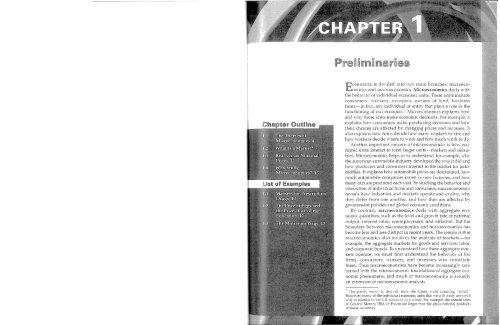Daniel l. Rubinfeld
Daniel l. Rubinfeld
Daniel l. Rubinfeld
You also want an ePaper? Increase the reach of your titles
YUMPU automatically turns print PDFs into web optimized ePapers that Google loves.
Ii<br />
lliI<br />
I<br />
Economics is divided into two main branches: microeconomics<br />
and macroeconomics. Microeconomics deals with<br />
the beha\'ior of individual economic units. These units include<br />
consumers, workers, investors, mvners of land, business<br />
firms-in fact, any individual or entity that plays a role in the<br />
functioning of our economy.! Microeconomics explains hovv<br />
and ''\'hy these units make economic decisions. For example, it<br />
explains how consumers make purchasing decisions and how<br />
their choices are affected by changing prices and incomes, It<br />
also explains ho'"" firms decide hm\' many workers to hire and<br />
how workers decide where to work and how much work to do.<br />
Another important concern of microeconomics is how economic<br />
units interact to form larger l.mits-markets and indush·ies.<br />
Microeconornics helps us to tmderstand, for example, why<br />
the American automobile industry developed the way it did and<br />
how producers and consumers interact in the market for automobiles.<br />
It explains how automobile prices are determined, how<br />
much automobile companies invest in new factories, and how<br />
many cars are produced each year. By studying the behavior and<br />
interaction of individual finns and consumers, rnicroeconomics<br />
reveals hO'N industries and markets operate and evolve, why<br />
they differ from one another, and hm·\' they are affected by<br />
government policies and global economic conditions.<br />
By contrast, macroeconomics deals with aggregate economic<br />
quantities, such as the level and growth rate of national<br />
output, interest rates, unemployment, and inflation. But the<br />
boundary between macroeconomics and microeconomics has<br />
become less and less distinct in recent years. The reason is that<br />
macroeconomics also involves the analysis of markets-for<br />
example, the aggregate markets for goods and services, labor,<br />
and corporate bonds. To understand how these aggregate markets<br />
operate, we must first understand the behavior of the<br />
firms, consumers, \\'orkers, and investors who constitute<br />
them. Thus macroeconomists have become increasingly concerned<br />
with the micro economic foundations of aggregate economic<br />
phenomena, and much of macroeconomics is actually<br />
an extension of micro economic analysis.<br />
1 The prefix micro- is derived from the Greek word meaning "small."<br />
However, many of the individual economic units that we will studv are small<br />
only in relation' to the Us. economy as a whole. For example, the aimual sales<br />
of General Motors, IBM, or Exxon are larger than the gross national products<br />
of many countries.

















